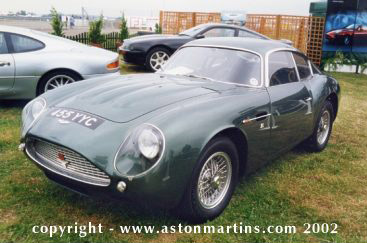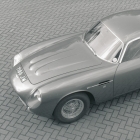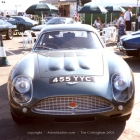After chassis had been completed in the workshops of Richard Williams (RSW), they headed out to Italy for the bodies to be added. These were constructed in the workshops of ex-Zagato employee Mario Galbiatti since Zagato themselves no longer had the facilities to do the work in-house. So as to ensure that the bodies of the Sanction 2 cars were identical to the original cars, Williams had his own car sent to Italy to be dismantled and used as a template. After delays due to Richard Williams involvement in the AMR1 Group C racing project, the four Sanction 2 cars were unveiled in July 1991 at the premises of RSW in Cobham, Surrey.
One example shown, (DB4GT/0192 – 455YYC); it is virtually identical to the earlier cars with some minor but significant modifications.
- Platform chassis based on DB4GT/0181/L with additional strengthening to improve torsional rigidity
- a slightly larger capacity 4.2 litre engine (4212cc, 3.7 litre on the original) with 50DC01/SP Weber carburetors (replacing 45DCOE’s) developing 352 bhp (up from 314)
- Front suspension as in 1961 but with adjustable and thicker anti-roll bar
- Rear suspension as in 1961 with improved location and adjustable
- Modern Goodyear Eagle NCT tyres on 15 inch diameter, 6 inch wide rims (down from16inch by 5 inch)
The stated cost of each recreated car (all pre-sold) was a massive £750,000 although in reality they may have actually cost around two thirds of that to build. Whilst one example passed through Brooks Geneva auction in March 1998 for a little under £310,000 plus buyers commission, more recently at Bonhams Works auction in 2012, another car made significantly more.
In no way can the Sanction 2 cars be seen as mere copies. They are absolutely accurate examples only separated by a period of 30 years from the first batch of cars. At the time of their unveiling, Victor Gauntlett described them as ‘works approved replicas’ as the project was blessed by both AML and Zagato. It must also be noted that a number of standard DB4 cars have been rebuilt with Zagato type bodies by such people as GTC engineering with Shapecraft, Goldsmith and Young, Aston Workshop, Desmond Smail, Stratton Motor Company and Fourways Engineering.
In 1992, RS Williams were given approval from AML to produce a further two cars from extra parts left over from the Sanction 2 project. The cars started out as standard DB4’s in poor condition and were completed in 2000. Zagato had apparently then stated that it wants no further cars to be built so as not to spoil the market. These cars have been named by the AMHT as Sanction 3 cars. As we now know, AML went on to create the Continuation series of DB4 GT Zagato from 2019.























